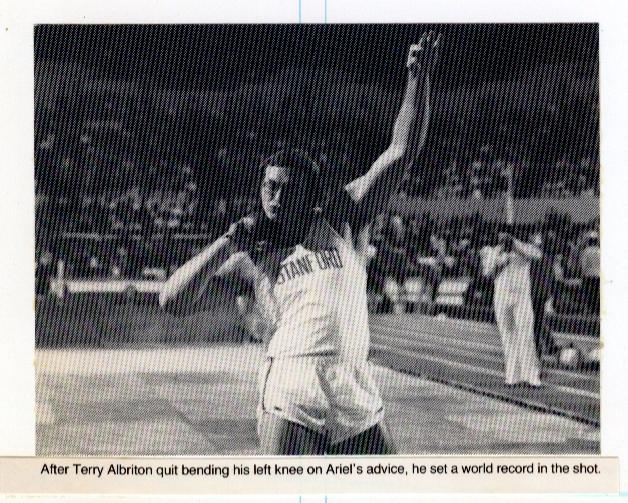| Previous | Index | Next |
![]()
back to California with the results, plopping 50-to-80-page computer print-outs into the bemused throwers' laps. One recipient was Mac Wilkins. The sheets of
numbers meant little to him, but not Ariel's interpretation. "He pointed out that my front leg was absorbing energy that could go into the throw," says Wilkins. "I had to begin to change my whole conception of throwing. I used to think I had to put as much of my speed as I could in the direction of the throw."
Ariel, citing Newton's law about every action requiring an equal and opposite reaction, said no. "It's vital to have everything stopping in the discus. In the best throws, we found a pattern. It is like using a fly rod, or snapping a towel. You have to decelerate the heavy parts, the legs and the trunk, so you can accelerate the light parts, the arm and the discus." Ariel spoke to Wilkins with special care, because the analysis had shown him generating incredible speed in one section of his spin. "He was like 30% faster than the rest, even though he was dissipating it at the end. But if you see that, you know the potential is there." The computer found that with a perfectly timed summation of his forces, Wilkins could throw the discus 250 feet.
"It seemed a little far at the time." says Wilkins, whose best was 219' I ". Indeed, the world record was 226' 8". But the second and third times Wilkins put Ariel's advice into practice, he broke the world record, eventually reaching 232' 6" and winning the Olympic gold medal at Montreal. He continues to throw, calmly
maintaining he has not lived up to his potential, and for once that is a judgment supportable with clear evidence.
Shotputter Terry Albritton's mistake
was similar to Wilkins'. "That front leg has to be the solid block you throw from," says Ariel. "What Terry was doing, bending that knee, was like trying to throw from a trampoline or shoot a cannon from a canoe." A year ago Ariel told AIbritton he could he the next worldrec-ord holder if he'd stop doing that. A month later Albritton was the next world-record holder, with a put of 71' 8'/7".
Sometimes the camera and corputer happen upon events that bluntly refute accepted theory. Long junipers have all trained by rising to their toes under heavy weights. strengthening their calves for the last push from the board. Ariel's analysis showed, however, that the best jumpers don't point their toes until the pushing foot is already two feet off the ground. "Far more important than the jumping leg is the free leg," says Ariel. "It and the torso accelerate as the planted leg decelerates. Then the jumping leg is yanked off the ground. That leg isn't pushing, it's trying to catch up."
In a study of Kansas City Royals pitchers, another commonsense belief fell to clear measurement. "You'd think if the forearm muscles that flick the wrist were stronger. you'd move the wrist faster and throw harder," says Ariel, illustrating by flapping a limb in the manner of a rather aggressive princess thrusting her hand out to be kissed. "But no. Because of the whip action, the concentration of force
from the legs and back and shoulder, the forearm is like the end of that snapping towel, the wrist snaps far faster than any muscle can contract. It just goes along for the ride, so it is absolutely useless to train the wrist."
No sport is immune to Ariel's iconoclastic examination. Not long ago, he and his staff spent 4,000 hours analyzing the behavior of tennis balls, filming them at 10,000 frames per second as they struck rackets and assorted surfaces.
"Tennis people think they can feel the hall on the racket. They talk as if they can do things to control it then," says Ariel, waving an imaginary racket. "We discovered that a tennis ball is on the racket approximately four milliseconds. Four one-thousandths of a second. Human reaction time is 120 milliseconds or more, so that ball is long gone before anybody feels it. It is off the racket even before the racket gives." Such a sharp jolt obviously packs a great deal of energy into the briefest of moments. "The muscles can't react to it, so the elbow, which is a single plane joint and can't pass any of the shock along, can briefly receive a hundred times the force it does when you throw something. No wonder people get tennis elbow."
The tennis ball study was commissioned by a manufacturer who will use the results to design balls that remain on the racket longer. But Ariel was most fascinated by having to devise a new equation to describe the behavior of elastic objects colliding at oblique angles. because these didn't seem to follow textbook physics. "The point of maximum compression is not the point of maximum force," he says excitedly. The commercial overtones of the research did not hold his interest. "They talk about light balls, heavy balls. Such craziness. All the brands were so much the same it was like they were made by the same machine."
Because so many of the body's reverberations end up in the feet, Ariel has long been interested in athletic shoes. "That is the witchcraft business, for sure," he says. "Shock absorption is the key to better distance running, no question, but look." He flips through a hook of data. "Some brands absorb 2,300 newtons, some only 1,000. That range! And the manufacturers don't even know what their own shoes do."
Ariel, using an exquisitely sensitive $25,000 force plate, which transmits readings of four kinds of pressure-vertical, forward, sideways and twistingto an oscilloscope, charted the forces of footstrike in different shoes at every
1
.. PnPT.c U r II' TPATFn n>>viiet 1077

![]()
| Previous | Index | Next |